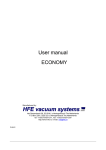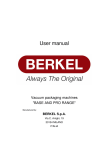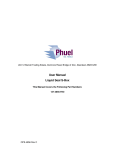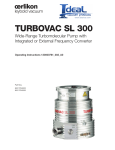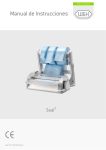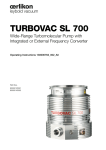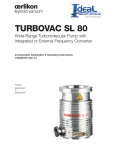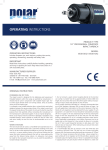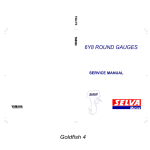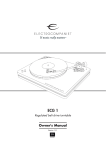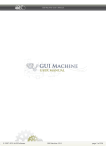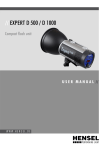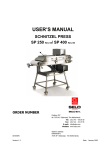Download User manual - Whaley Food Service
Transcript
Art. no. 96.06.5.1505/05.03 http://www.turbovac.nl, e-mail: [email protected]. User manual Vacuum packaging machines "STE-Series" “SB-Series” Manufactured by: Het Sterrenbeeld 36, 5215 ML 's-Hertogenbosch, The Netherlands P.O.Box 2261, 5202 CG 's-Hertogenbosch, The Netherlands tel: +31(0)73-6271271, fax: +31(0)73-6271200 http://www.hfe.nl, e-mail: [email protected] 2003 HFE Vacuum Systems BV All rights reserved. No part of this document may be reproduced and/or published by means of printing, photocopy, microfilm or any other method, without the prior written permission of the manufacturer. This also applies for the accompanying illustrations and/or diagrams and schematics. The information in this document is based on the general data associated with the construction, material qualities and working methods, known at the moment of publication, so that we reserve the right to make changes without giving prior notice. This document is applicable to the indicated models of the Turbovac packing machine in the version supplied. The manufacturer therefore does accept any liability for any form of damage or injury resulting from deviating from the specifications of these machines as supplied to you. All possible care was taken when creating this document, but the manufacturer accepts no liability for mistakes or any consequences thereof. TAKE THE TIME TO READ THIS DOCUMENT THOROUGHLY TO ACQUAINT YOURSELF WITH THE CORRECT AND APPROPRIATE USE OF THE TURBOVAC VACUUM PACKING MACHINES. 2003-05 2 96.06.5.1505-IM-en/05.03 Preface CONTENTS 1. General......................................................................................... 5 2. Safety instructions and danger warnings................................. 7 3. The machine .............................................................................. 11 3.1 Operation .....................................................................................................11 3.1.1 3.1.2 3.2 Options ........................................................................................................11 3.2.1 3.2.2 3.2.3 3.2.4 3.2.5 3.2.6 4. Sensor control.................................................................................................... 11 Time control ....................................................................................................... 11 Less-vacuum...................................................................................................... 11 Vacuum plus (vac+) ........................................................................................... 12 Gas .................................................................................................................... 12 Sealing ............................................................................................................... 12 Soft-air ............................................................................................................... 12 Multi-cycle .......................................................................................................... 12 Installation ................................................................................. 13 4.1 Machines with a transparent cover ...........................................................13 4.2 Machines with a metal cover......................................................................14 4.3 Installation ...................................................................................................15 4.4 Connecting the gas.....................................................................................16 4.5 Connecting the seal-pressure....................................................................16 5. Control panel “STE-series”...................................................... 17 5.1 Control panel...............................................................................................17 5.1.1 5.1.2 5.2 Programming of the STE-series control ...................................................19 5.2.1 5.2.2 5.2.3 6. Symbols ............................................................................................................. 18 Factory settings.................................................................................................. 18 Programming with an open cover ...................................................................... 19 Programming with a closed cover...................................................................... 20 Special functions................................................................................................ 21 Control panel “SB-series”........................................................ 23 6.1 Control panel...............................................................................................23 6.1.1 6.1.2 6.2 Programming of the SB-control.................................................................25 6.2.1 7. Symbols ............................................................................................................. 24 Factory settings.................................................................................................. 24 Programming with an open cover ...................................................................... 25 Packing ...................................................................................... 26 7.1 Dry products................................................................................................26 7.2 Moist and fluid products ............................................................................28 96.06.5.1505-IM-en/05.03 3 Preface 8. Maintenance ...............................................................................29 8.1 Cleaning ...................................................................................................... 29 8.2 Cover rubber............................................................................................... 29 8.2.1 8.2.2 Machines with a transparent cover .................................................................... 29 Machines with a stainless cover ........................................................................ 30 8.3 Power cable ................................................................................................ 30 8.4 The vacuum pump...................................................................................... 30 8.4.1 8.4.2 8.4.3 8.5 8.6 Oil dampers and springs ........................................................................... 32 Sealbeams and counter beams................................................................. 33 8.6.1 8.6.2 8.6.3 8.6.4 8.6.5 8.6.6 8.7 Warming up the pump (STE-series) .................................................................. 30 Filling with oil...................................................................................................... 31 Changing the oil ................................................................................................. 32 Replacing seal wire and teflon tape (single seal beam) .................................... 33 Replacing the seal wire(s) and the teflon tape (stainless seal beam) ............... 34 Replacing the seal wire(s) and the teflon tape (aluminium seal beam)............. 35 Fitting new wires on the seal beam: .................................................................. 35 Teflon lining to the seal beam ............................................................................ 36 Replacing the counter beam silicon rubber ....................................................... 36 Vacuum hoses and pipes .......................................................................... 36 9. Faults and messages ................................................................37 10. Technical data............................................................................40 10.1 Machines in the stainless series............................................................... 40 10.1.1 10.1.2 11. 4 Machines with a transparent cover (Table top and Mobile)............................... 40 Machines with a metal cover (Heavy duty) ........................................................ 41 10.2 Machines in the aluminium series ............................................................ 42 10.3 Connections ............................................................................................... 43 10.4 General data ............................................................................................... 43 CE-Declaration ...........................................................................44 96.06.5.1505-IM-en/05.03 Preface 1. GENERAL Use of the manual This manual is intended as a reference for users and technicians, who can install, use and maintain the machine(s) stated on the front of this document in a safe way. Pictograms and symbols at the machine At the machine the following pictograms and symbols are attached to the machine: WARNING First consult the documentation with regard to: Connecting the gas. CONNECTING THE SEAL PRESSURE. Danger of electrical shock. • Before opening: First remove the plug from the wall socket! • Only qualified personnel are allowed to open the unit. Connection for extra sealing pressure Connection for gas Pictograms and symbols at the machine In this manual the following pictograms and symbols are used (Fig. 4-2, Fig. 4-4, Fig. 4-6 of Fig. 4-7): Note Suggestions and advice to make carrying out the particular tasks or actions easier. Warning Procedures that can result in damage to the machine, the surroundings and the environment or physical injury when not carried out carefully. DANGER DANGER OF ELECTRICAL SHOCK! Attention for the environment Residual substances can contain valuable substances and materials that can be suitable for recycling. Waste may also contain substances that are harmful to the environment. 96.06.5.1505-IM-en/05.03 5 Preface Illustrations Because of the number of types and models it is impossible for practical reasons to illustrate every variation. Nevertheless, the illustrations used show the principles of operation of the machine identified on the front of this document. Service and technical support For information concerning specific settings, maintenance or repair work that is outside the scope of this manual, contact the supplier of the machine. He is always ready to help you. Make sure that you have the following data available: • machine type • serial number This data can be found on the identification plate. Identification of the machine The identification plate (Fig. 1-1) contains the following data: A. Type B. Serial number C. Year of manufacture A D. Number of phases – voltage (Volt: V) B E. Frequency (Hertz: Hz) D F F. Current (Ampere: A) E G G. Weight (kilogram: kg) C Fig. 1-1: Identification plate 6 96.06.5.1505-IM-en/05.03 Safety instructions 2. SAFETY INSTRUCTIONS AND DANGER WARNINGS General The manufacturer accepts no liability whatsoever for damage or injury caused by not (strictly) following the safety directions and instructions in this manual, or carelessness during the installation, use, maintenance and repair of the machines identified on the front of this document and any accompanying options. The owner of the machine is responsible at all times for observing the locally applicable safety regulations and guidelines. Obey all safety instructions and guidelines as given in this manual. Users manual • • • Every user should be informed of the contents of this manual and follow the instructions in it carefully. Management must train personnel on the basis of this manual and obey all directions and indications. Never change the order of the actions to be taken. Always keep the manual in the proximity of the machine. Pictograms and instructions on the machine • • • The pictograms, warnings and instructions that have been attached to the machine are part of the safety measures taken. They should not be damaged or removed and they should remain present and readable throughout the entire life span of the machine. Replace or repair unreadable or damaged pictograms, warnings and instructions immediately. Intended use of the machine1 The machine is designed for vacuum packaging food products, for 8 hours a day, 5 days a week. Any other or extended use is not according to the purpose. The manufacturer accepts no liability for damage or injury resulting from this. Use the machine only in a technically perfect condition, in accordance with the purpose described above. Technical specifications The specifications stated in this manual may not be changed. Modifications Modification of (parts of) the machine is not permitted. *1 The "Use in accordance with purpose” as established in EN 292-1 is the use for which the technical product is suitable according to the statement by the manufacturer – including his directions in the sales brochure -. When in doubt it is the use that appears to be the most usual from the construction, model and function of the product. Use in accordance with the purpose means observing the instructions in the users manual. 96.06.5.1505-IM-en/05.03 7 Safety instructions Safety precautions The machine is fitted as standard with the following safety precautions: • • • • Main switch Cover switch Short circuit and overload safety Pump fan guards Main switch With the main switch (Fig. 2-1) the machine can be made voltage free. The main switch can also be used as an emergency stop. Cover switch The Cover switch prevents the sealbeam(s) getting hot as a result of a malfunction or defect when the Cover is open. Fig. 2-1: Main switch WARNING THE SAFETY WORKS CORRECTLY WHEN THE MACHINE APPLIES A VACUUM, WHEN THE COVER IS ALMOST CLOSED. THIS SAFETY MUST BE CHECKED FOR CORRECT OPERATION REGULARLY AND, WHEN NECESSARY, IT MUST BE REPAIRED IMMEDIATELY. Short circuit and overload safety The machine is equipped with safety measures that prevent components becoming overheated by overloading or short-circuiting. Notes! The overload safety circuits on the seal transformers are self-resetting, which means that the safety resets itself when the transformer has cooled down sufficiently. Operate the machine at a slower speed or decrease the sealing time if the overload safety is trips regularly. Obviously, tripping the overload safety shortens the lifetime of the transformer. On some machines extra sealing power (see chapter 1) can be installed. Consult your dealer. The short-circuit safety on the seal transformer is not self-resetting, which means that the transformer must be replaced when this safety is tripped. Consult your dealer for this. • • • Pump fan guards The vacuum pump is fitted with guards that prevent you touching the fan while it is running. Safety measures • All safety measures must be mounted correctly and may only be removed for maintenance and repair work by suitably trained and authorised service technicians. The machine may never be used if the safety measures are not complete or not present, or when they are or have been disabled. Safety measures may never be bridged. • • 8 96.06.5.1505-IM-en/05.03 Safety instructions Use • • • • • • • • Inspect the machine before use and check it for damage. Switch the machine off at the main switch if it is not used for a long time. Never use sharp objects to operate the keys. Do not allow unauthorised persons into the working environment. Always ensure there is adequate ventilation, especially in confined places. Wear clothing that is suitable for the work. Loose clothing or jewellery can get between the Cover and the vacuum chamber. Never use the machine in an environment in which there is an explosion risk. Replace the supply cable if it is damaged. Make sure that the supply cable cannot be damaged by trapping this cable. Hygiene • • • • Cleaning the machine is of the utmost importance when food products are wrapped. Clean the machine regularly and thoroughly, preferably every day (§ 8.1). Work hygienically and prevent direct contact between the product and the machine as much as possible. Keep the operating controls free of dirt and grease. Lock the Cover if the machine will not be used for an extended period. This protects the vacuum chamber from dust and dirt. Service, maintenance and repairs A clear distinction is made in this manual between the service, maintenance and repair work that can be carried out by the user, and that which is reserved for trained and qualified service technicians only. • • • • • • • • Make sure there is adequate lighting. Always switch off the machine at the main switch during maintenance and/or repairs and/or remove the plug from the socket. Observe the maintenance intervals specified. Overdue maintenance can lead to high costs for repair and servicing and the right to guarantee can be lost. Always use parts, materials, lubricants and service techniques approved by the manufacturer. Never use worn tools and do not leave any tools inside the machine. Do not carry out service, maintenance or repair work to the machine, when it is indicated that the dealer or qualified service technician should carry it out. Always have a recognised Turbovac dealer carry out repair and maintenance work. Safety measures that have been removed in order to carry out service, maintenance or repairs must be refitted immediately after this work and they must be checked for correct operation. 96.06.5.1505-IM-en/05.03 9 Vacuum machines and the environment Vacuum packing machines and the environment Packaging The packaging that is for the transportation and protection of the machine is mainly made of cardboard and/or wood, which are suitable for recycling. Do not dispose of the packaging as industrial waste but ask the sanitation department of your local government authority where you can hand in the material. Machine When you dispose of your machine, it can still contain valuable substances and materials. Do not dispose of the machine as industrial waste, but enquire at your local government authority about the possibilities for recycling or environmentally friendly disposal of the material. • Most parts of the machine have been manufactured from stainless steel and can be disposed of as scrap metal in the normal way. From health and environmental considerations, no asbestos has been used. • The printed circuit boards and the components mounted on them are electronic waste. Deliver old printed circuit boards to specialised companies for environmentally friendly processing. Oil Ask the sanitation department of your local government authority where you should take the used oil for an environmentally friendly processing. 10 96.06.5.1505-IM-en/05.03 The machine 3. THE MACHINE Products can be vacuum packed with the Turbovac vacuum packing machine. The food products or products that are to be vacuum packed are put in a vacuum bag. This is placed in the vacuum chamber of the machine. Then the cover is closed and the vacuum pump starts sucking the air out of the chamber. When the required vacuum level has been reached, the opening of the bag between the sealbeam and the counter beam is pushed together, after which the bag gets sealed. After that the vacuum chamber ventilates and the cover opens automatically. The packed product can now be taken out of the vacuum chamber. 3.1 Operation The machine is equipped with a control system whose software prevents illogical settings being made. The control has nine programs that can be changed as desired. Because of this it is possible to pack various kinds of products perfectly in a simple way. Note The factory settings can always be recalled, which erases the programs that have been entered by you (§ 5.1.2 en § 5.2). 3.1.1 Sensor control The machine is equipped with a very accurate sensor control. With this sensor the pressure in the vacuum chamber is measured during vacuuming and, when appropriate, during the gassing and slow venting (soft-air option). The machine carries out the particular function automatically until the set pressure has been reached. Because of this the result of that particular function is independent of the air volume in the chamber or of the surrounding pressure, which guarantees a constant packing quality. Notes • • 3.1.2 The vacuum pressure is indicated in mbar. The factory setting is from 5 mbar to 999 mbar. A changeable surrounding pressure has no effect on the measurement (for example when using in an area on high mountains). Time control The sensor control can be switched off. The machine now operates via time control. This means that the vacuum, gas and soft air functions operate until the set time has elapsed. Notes • • 3.2 To change from sensor control to time control, see § 5.2.3. The vac+, seal1 and seal 2 functions are always time controlled. Options The Turbovac machines can be equipped with the following options: 3.2.1 Less-vacuum With this option the vacuum level can be set to over 200 mbar. The vacuum level for a machine without the less-vacuum option is limited to 200 mbar. The 330-STE, 430-STE, 450-STE and 490-STE are equipped with this option as standard. 96.06.5.1505-IM-en/05.03 11 The machine 3.2.2 Vacuum plus (vac+) This option allows extra vacuuming, to give the air that is trapped inside the product time to escape from the product. When the vac+ function is activated, the machine continues to vacuum for the set vac+ time after reaching the set vacuum level. This option can only be activated with a sensor control. Note: The 330-STE, 430-STE, 450-STE and 490-STE machines are standard supplied with this option. 3.2.3 Gas This option is used when delicate products must be packed. Applying certain mixtures of gas can lengthen the storage life of the product. A machine with the gas option is also equipped with the less-vacuum option. 3.2.4 Sealing With the help of the following options optimal sealing of the vacuum bag can be achieved for every situation Different sealing seams • • • • Single seal Standard seal wire Double seal For extra seal security, two equal width sealing wires are mounted on the sealbeam. This sealing method is the standard model. Cut-off seal For simple removal of the bag surplus, a thin cutting wire is mounted next to the seal wire. The thin cutting wire melts through the bag. Seal 1/2 The sealbeam is equipped with a sealing and a cutting wire, just like the cut-off beam. In this model the time for sealing (the seal1 time) can be set independently of the cutting time (the seal2 time). This option is used when the sealing and cutting times cannot be the same, such as with shrinking bags. Extra seal pressure With this option the seal pressure can be increased with compressed air (maximum 1 bar). The extra pressure makes sure that the sealbeam is pushed harder against the counter beam during sealing. This option should especially be fitted when the sealbeam is melting badly and a longer sealing time gives insufficient improvement. This situation can occur especially when using the gas option. The higher the gas pressure set, the more useful the extra seal pressure is. Every machine but 530-STE AND 590-STE with gas setting over 500 mbar prefers extra seal pressure. 3.2.5 Soft-air This option can be used when delicate products, or products with hard protrusions must be packed. The vacuum chamber is then vented slowly so that the bag has the time to shape itself softly around the product. A machine with the soft-air option is also fitted with the less-vacuum option. 3.2.6 Multi-cycle With this option the packing can be made even more fee of oxygen. The machine vacuums and gasses more times in a row. The oxygen-free gas flushes out the residual air from the vacuum chamber so that there is less oxygen left in the packing. A machine with the multi-cycle option is also fitted with the gas option and the less-vacuum option. 12 96.06.5.1505-IM-en/05.03 Installation 4. INSTALLATION 4.1 Machines with a transparent cover K J I H G A B C D L E Fig. 4-1: Table model M N O Fig. 4-2: Table model (connector side) K J I H G P A B C D E Fig. 4-3: Single chamber model (movable) Pos. A B C D E F G H Description Control panel Gas pipes Cover lock Sealbeam Filling plates Ventilation opening Identification plate Suction opening 96.06.5.1505-IM-en/05.03 L M N F O Fig. 4-4: Single chamber model (connector side) Pos. I J K L M N O P Description Silicon gasket Transparent cover Preassure beam Stickers Gas connection Connection for extra seal pressure Power cable Wheel with brake 13 Installation 4.2 Machines with a metal cover D J I H G K E C P A B L Fig. 4-5: Single chamber model (movable) M N F O Fig. 4-6: Single chamber model (connector side) J I D M K G N L O H A B P E Fig. 4-7: Double chamber model (with connectors) Pos. A B C D E F G H 14 Description Control panel Gas pipes Cover lock (not for double chamber machines) Sealbeam Filling plates Ventilation opening Identification plate Suction opening F Fig. 4-8: Double chamber model Pos. I J K L M N O P Description Silicon gasket Metal cover Preassure beam Stickers Gas connection Connection for extra seal pressure Power cable Wheel with brake 96.06.5.1505-IM-en/05.03 Installation 4.3 Installation 1. Unpack the machine. WARNING • • • Only transport the machine upright. Do not tilt the machine. Take care no one gets trapped while transporting the machine. Apply the brake, when using the machine. 2. Level the machine on a flat firm surface. WARNING • • Never install the machine in front of entrances, exits or passages that are intended for emergency services. Make sure that the machine is free on all sides so that proper ventilation is ensured. Take care the ventilation and/or openings air output are free so that the pump cannot become overheated. 3. The vacuum pump must be filled with oil. • • Check the oil level of the machine. Fill the pump of the table model with oil (§ 8.4.2). WARNING • Never start the machine if there is no oil in the pump. 4. Connect the machine electrically. WARNING • • • Check if the voltage and the frequency stated on the identification plate on the rear of the machine (see fig. 1: D and E) agrees with the voltage and the frequency of the electricity supply. Check that the electric current is sufficient for this machine (see fig. 1: F). Check the direction of rotation of the vacuum pump on a 3-phase machine as follows: Switch on the machine. Switch off the machine immediately after the pump starts at the main switch Check the rotation direction of the pump while it is runs down. An arrow on the motor indicates the correct direction of rotation. Switch over the 2 wires in the power plug if the rotation direction is not correct. When in doubt, contact your dealer. DANGER • • 96.06.5.1505-IM-en/05.03 Check that the electrical connection is properly earthed. Check that the connection cable is not trapped or damaged. Have the dealer or a qualified technician replaces a damaged connection cable immediately. 15 Installation 5. Open the cover by undoing the cover lock (by single chamber models). Note The cover opens automatically. 4.4 Connecting the gas Connect the gas to the gas connection at the rear of the machine (Fig. 4-2, Fig. 4-4, Fig. 4-6 of Fig. 4-8). WARNING • Use a suitable hose that fits the gas connection properly. Secure the hose with a hose clamp. • Anchor the gas bottles firmly so that they cannot fall over. • The pressure at the gas connection may not be over 1 bar. • Do not use any inflammable, explosive, toxic and/or corrosive gasses. When in doubt, consult your dealer. • Do not use gas mixtures that contain more than 21 % oxygen because of the risk of explosion. • Make sure that the room is well ventilated: there must be a constant flow of fresh air for the operator. 4.5 Connecting the seal-pressure Connect the compressed air to the seal connection at the rear of the machine (Fig. 4-2, Fig. 4-4, Fig. 4-6 of Fig. 4-7). WARNING • • • • • • • 16 Use a suitable hose that fits the gas connection well. Secure it with a hose clamp. Use only clean, dry compressed air. If no compressed air is available, the gas from the gas-option can also be used. This does increase the gas consumption. Never connect the compressed air to the gas connection. The pressure at the seal connection may not be over 1 bar. Use a suitable hose that fits the gas connection well and secure it with a hose clamp. Use only clean, dry compressed air. If no compressed air is available, the gas from the gas-option can also be used. This does increase the gas consumption. A connection for gas can also be fitted on the machine. Never connect the compressed air to this connection. The pressure at the seal connection may not be over 1 bar. 96.06.5.1505-IM-en/05.03 Control panel 5. CONTROL PANEL “STE-SERIES” 5.1 Control panel Fig. 5-1: Control panel Table 1: Control panel STE-series Nr. Item Function A Main switch • To switch the machine on and off. Stop-key • “Resetting” of the oil counters by pressing the key for 5 seconds. B • Emergency stop. • Stopping the packing cycle. The control supplies the vacuum chamber with air. • Stopping the programming (of a program or a special function) The changed values are not stored. C Change program • Programming the chosen program. • Recall the factory setting by pushing in the key for 5 seconds. • Storing the changed program values or special functions. D Next function • Step by step showing of the values of the selected program. • Continuing to the next step in the packing cycle. • Recalling of the next program value or special function. E Options on/off-key • Shortcut key to switch the most important option of the selected program on or off. • Programming the special functions by pressing the key for 5 seconds. • Switching the selected option on or off during programming. F G–M Up- and down key • Selecting a different program number or the warming-up position. Symbols • The symbols, the selected program is going to carry out are illuminated. • Increasing or decreasing the program value or special function. • The symbol of the operating function is illuminated during packing. • The symbol of the value that is programmed is illuminated. 96.06.5.1505-IM-en/05.03 17 Control panel Nr. Item Function N–O LED’s • The mbar-LED lights up when there is a sensor controlled operation. The sec.-LED lights up when there is a time-controlled operation. • The display shows the program value or special function that is programmed. The display shows "off" when the particular option is turned off. P Display • The display shows the selected program number. • During packing, the display shows the current value of the function that is being carried out. • The display shows the program value or special function that is programmed. The display shows “off” when the particular option is turned off. 5.1.1 Symbols Each hidden symbol (Table 2) at the control panel represents a function or an option. The meaning of each symbol is as follows: Table 2: Hidden symbols Vacuming (Vac) 5.1.2 Vacuum plus (Vac+) Gassing (gas) Seal1 Seal2 Soft-air Airing Factory settings The factory operating settings are shown in the following table. By programming the operation these values can be changed. The factory settings can always be recalled. (§ 5.2.1). The programmed values are then erased. Table 3: Factory settings Nr. 1 2 3 4 5 6 7 8 9 18 Sensor controlled Time controlled Vac Vac+ Gas Seal1 Seal2 Soft air Vac Gas Seal1 Seal2 Soft air Mbar 10 10 10 10 10 10 10 10 10 sec 5 “off” “off” “off” “off” “off” “off” “off” “off” Mbar “off” “off” 200 “off” “off” 200 200 “off” 200 sec 2,0 2,0 2,0 2,0 2,0 2,0 2,0 2,0 2,0 sec “off” “off” “off” 2,5 “off” 2,5 “off” 2,5 2,5 sec “off” “off” “off” “off” 400 “off” 400 400 400 sec 30 30 30 30 30 30 30 30 30 sec “off” “off” 5 “off” “off” 5 5 “off” 5 sec 2,0 2,0 2,0 2,0 2,0 2,0 2,0 2,0 2,0 sec “off” “off” “off” 2,5 “off” 2,5 “off” 2,5 2,5 sec “off” “off” “off” “off” 5 “off” 5 5 5 96.06.5.1505-IM-en/05.03 Control panel 5.2 Programming of the STE-series control The factory operating settings can be adapted to your own requirements very simply by programming the control. The factory operating settings are copied than. The factory settings can always be recalled again. Note When different products are packed regularly, it is useful to program a separate program for each product. For instance program 1 can be used for packing meat, program 2 for packing sauce, program 3 for packing vegetables, and so on. In order to pack a product one only needs to select the correct program. You can program at two different ways, namely: • • 5.2.1 With open cover. This is the most usual way to adapt a program. With a closed cover. This method of programming is especially useful if liquid products have to be packed (§ 7.2). Programming with an open cover 1. Switch the machine on at the main switch. The control starts up. Notes • • • • After the control has started the last used program is loaded. When the lid is closed during the start-up procedure, the vacuum chamber will be vented first until the cover opens. 2. Select the program number, which should be reprogrammed, with the up- and down keys. 3. Push the progr-save-key. The vac-symbol lights up. The vacuum level flashes on the display. Note By pressing the progr-safe-key for 5 seconds, the factory settings are recalled, and the settings that were programmed are erased. The control then starts again. 4. Change the value with the up- and down key. 5. Press the step key to set the next value. All functions can be set step-by-step, during which the appropriate symbol lights and the value is indicated in the display. 6. Press the options on/off key to switch an installed option on or off. When the option is turned off, the display shows “off”. When the option is switched on, the value can be changed with the up- and down key. 7. Press the progr-save-key to save the changes. The control returns to stand-by. 96.06.5.1505-IM-en/05.03 19 Control panel Notes • The control returns to the stand-by position without the changes being saved, by pressing the stop key. • The vacuum- value cannot be set to more than 200 mbar on a machine without the less-vacuum option. • The vacuum- and gas value cannot be set to more than 500 mbar at the machines, type 330-STE, 430-STE, 450-STE and 490-STE without extra seal pressure option. • The vacuum and gas value cannot be set to more than 800 mbar on any machine. • The gas value cannot be set below the vacuum level. • The soft-air value cannot be set to more than 999 mbar. • The soft-air value cannot be set below the gas value or the vacuum level. 5.2.2 Programming with a closed cover At this programming way, the machine carries out a packing cycle. Through the transparent cover is clearly to see when the product starts cooking. By pushing the step-key the machine stops vacuuming and starts executing the next step in the packing cycle. The reached value of vacuum is remembered by the operation. (§ 7.2). See step 1 to 3 of § 5.2.1. Notes • Take care the vac+-option is switched off. 1. Press the progr-save-key. The symbol of the vacuum level starts to illuminate. 2. Close the cover. WARNING ALWAYS USE TWO HANDS TO SHUT THE COVER. 3. The pump starts vacuuming the chamber. The vac-symbol is illuminating. 4. The display shows the actual value. 5. Push the step-key as the required value is reached. The next step in the packing cycle is executed. The value is remembered. At this way also the gas- and soft-air-values can be programmed. 6. As the last step the chamber is aired and the cover opens. The values are stored and the operation returns to stand-by. Notes • • • • • 20 The seal1 and seal2-value cannot be programmed at this way. The value(s) as those in the memory are executed. The gas- and soft-air-value only can be programmed if these options are switched on. By pushing the stop-key the programming is stopped, without storing the modifications. If the step-key is not pushed and the maximum is reached, the operation starts the next function. If the step-key is not a single time pressed during the cycle, the program values are not changed after the cycle is finished. 96.06.5.1505-IM-en/05.03 Control panel 5.2.3 Special functions The control has a number of special functions. Moreover information can be read, through what the dealer can support you better at possible problems. Switches on the machine with the main switch (Fig. 5-1-A). The control starts up. Push the options on/off-key 5 seconds. At the display the first function with its setting appears (Table 4). Adjust the setting with the + and – keys (up and down keys). Push the step-key to adjust the following special function. In this way all special functions can be adjusted step by step. Next to it the belonging information can be read. In the table below all steps are showed. Notes • • • • The adjustments been in force for all programs. By step 5, 6 and 7 the + and – keys have no function (Table 4). The multi-cycle adjustment only can be adjusted as this function is built in. At a multi-cycle a number of vacuum- and gas-actions are executed after each other before the bag is sealed. A multi-cycle starts always with the vac-action. This means that the vac-action is the last if an odd figure is imported. At an even number the gas-action is the last action. If the value 0, 1 or 2 is adjusted, the function is switched off, or has no influence on operating the machine. Push the progr-save-key to store the modifications. Note By pushing the stop-key the programming of the special functions is left, without storing the modifications. Table 4: Special functions Step Adjustment Display 1 Start position oil-cyclecounter C## Start position oil-hours counter h## 3 Sensor- or time control SF# 4 Multi-cycle actions rC# 2 96.06.5.1505-IM-en/05.03 Meaning of the dashes Start position in hundreds of cycles. Setting of the manufacturer 2000 cycles 9000 cycles Start position in tenth of operation hours 450 hours 0: the control works time-controlled. 1: the operation works sensor operated. The number of multi-cycle actions. 1 900 hours 330-STE, 430-STE, 450-STE, 490-STE, SB-420 530-STE, 590-STE, 580-STE, 880-STE, 700-STE, 900-STE, 950-STE, 1000-STE SB-520, SB-820, SB-620 330-STE, 430-STE, 450-STE, 490-STE, SB-420 530-STE, 590-STE, 580-STE, 880-STE, 700-STE, 900-STE, 950-STE, 1000-STE SB-520, SB-820, SB-620 0 (off) 21 Control panel Step 5 Information Software version Display U## 6 Dipswitch adjustment Serial number of the operation d## 7 22 n# Meaning of the hashes The version number. (After pressing '+" or "–" key, the release number is indicated.) A code representing the dipswitch setting (the electronic adjustment of the machine). The dash reproduces the first digit of the serial number. The complete number is readable step by step by pushing the up-key. Alternatively a little point is put on and off. 96.06.5.1505-IM-en/05.03 Control panel 6. CONTROL PANEL “SB-SERIES” 6.1 Control panel A B -0.6 D E F G H I -0.4 -0.2 -0.8 -1 C bar -0 acc.1.6 Fig. 6-1: Control panel SB-series Table 5: Control panel SB-series Nr. A B Description Vacuum gauge Stop-key Function C Progr. save-key • Programming the chosen program. D Symbols E LED’s F Display • For indicating the reached vacuum. • Stopping of the current action. The control starts the following action. • Stopping the programming (of a program or a special function) The changed values are not stored. • • • • • • • G–H Up- and down key I Main switch 96.06.5.1505-IM-en/05.03 • • • • Storing the changed program values or special functions. The symbols that will carry out the chosen program. During packing the LED of the operative function will light up. The LED of the operating function is illuminated during packing or programming. The display will show the chosen program number. During packing the display shows the actual values of the function that is being executed. The display shows the program value or special function that will be programmed. The display shows “off” if the option concerned is off. Choosing another program number. Increasing or decreasing of the program value or special function. Switching on and of off the machine. Emergency stop. 23 Control panel 6.1.1 Symbols Each symbol (Table 6) at the control panel represents a function or an option. The meaning of each symbol is as follows: Table 6: Symbols Vacuming 6.1.2 Gassing Seal1 Seal2 Soft Air Airing Factory settings The factory operating settings are shown in the following table (Table 7). By programming the operation these values can be changed. Table 7: Factory settings Nr. 1 2 3 4 5 6 7 8 9 24 Time controlled Vac Gas Seal1 Seal2 Soft air sec 30 30 30 30 30 30 30 30 30 Sec “off” “off” 5 5 “off” “off” “off” “off” “off” sec 2,0 2,0 2,0 2,0 2,0 2,0 2,0 2,0 2,0 sec “off” “off” “off” “off” “off” “off” “off” “off” “off” sec “off” 5 “off” 5 “off” “off” “off” “off” “off” 96.06.5.1505-IM-en/05.03 Programming 6.2 Programming of the SB-control The factory operating settings can be adapted to your own requirements very simply by programming the control. The factory operating settings are copied than. However your dealer can always recall the factory settings again. Note When different products are packed regularly, it is useful to program a separate program for each product. For instance program 1 can be used for packing meat, program 2 for packing sauce, program 3 for packing vegetables, and so on. In order to pack a product one only need to select the correct program. You can only program with an open cover. 6.2.1 Programming with an open cover 1. Switch the machine on at the main switch. The control starts up. Notes After the control has started, the last used program is loaded. When the lid is closed during the start-up procedure, the vacuum chamber will be vented first until the cover opens. 2. Select the program number, which should be reprogrammed, with the up- and down keys. 3. Push the prog-key for 5 seconds. • The vac-symbol lights up. • In the display you will see the vacuum time. 4. Adjust the value with the up- and down keys. 5. Press the prog-key to store the changes and to adjust the next value. All functions can be set step-by-step, during which the appropriate symbol lights and the value is indicated on the display. 6. Press the prog.-key to store the latest changes. The control returns to stand-by. Notes: The control returns to the stand-by position without the changes being saved, by pressing the stop key. 96.06.5.1505-IM-en/05.03 25 Packing 7. PACKING With this machine products of various natures can be packed. In general, they can be divided into: • • Dry products Moist or fluid products. WARNING CHECK THE TRANPARENT COVER AT DAMAGES OR CRACKS, BEFORE STARTING PACKAGING. REPLACE A DAMAGED COVER IMMEDIATELY. 7.1 Dry products 1. Switches on the machine at the main switch (Fig. 5-1-A). The control starts up. You can now see at a glance how the product is being packed: The display indicates the program number. • The symbols of the functions that the program is carrying out during packing are illuminated. • The “mbar LED” lights for sensor-controlled operation and the “sec LED” lights for timecontrolled operation. Notes • During the start, 3 points on the display lights up. • After the operation is started the last used program is loaded. • When the cover is closed the vacuum chamber is vented until the cover opens. During venting, the venting symbol lights and horizontal beams on the display flashes. 2. Select the required program number with the up- and down keys (Fig. 5-1-F). Note It is also possible to select the warming-up position with the up- and down keys. The symbol lights now one by one (§ 8.4.1). 3. Put the product in a vacuum bag. (Fig. 7-1). A B C D Notes • The bag should not be filled for more than three-quarters. • Keep the closing side of the bag properly clean. 4. Remove or position one or more inlay plates to adjust the height of the product correctly (Fig. 7-1-A). 5. Put the vacuum bag (Fig. 7-1-B) with the product in it in the vacuum chamber. Fig. 7-1: Packing 26 96.06.5.1505-IM-en/05.03 Packing Notes • Position the opening of the bag, without folds, on the sealbeam (Fig. 7-1-C). Make sure that the opening of the bag does not stick out the vacuum chamber. • With a machine with gas-option, the opening of the bag must be pushed properly over the gas outlets (Fig. 7-1-D). • Be hygienic: avoid immediate contact between the machine and the products. 6. Close the cover. The vac-symbol lit. The pump starts to vacuum the chamber. Note At the types 530-STE, 590-STE, 580-STE, 880-STE, 700-STE, 900-STE, 950-STE, 1000-STE, SB-520, SB-820 and the SB-620: If the vacuum pump is not running, the pump starts automatically by closing the cover. WARNING • Always use both hands to close the cover. • The machine starts to vacuum when the lid is almost closed. If this is not the case have the dealer or qualified service technician repair this. Stop working. The machine finishes the chosen program, during which the appropriate symbol is lit stepby-step, and the current value is indicated on the display. As final step the chamber is vented, after which the lid opens automatically. Notes • By pressing the step key, the next step in the cycle is carried out. • By pressing the stop key the packing cycle is stopped and the chamber is vented. Venting only stops when the cover is opened. • At the types 330-STE, 430-STE, 450-STE, 490-STE and SB-420 the pump stops if the cover opens. • At the other types the pump stops automatically if the machine is not used for 5 minutes. • Close the gas bottles when they are not in use. • Do not get frightened by a warm sealbeam. The sealbeam can get warm, especially when used intensely. Use gloves when necessary. Shorten the sealing time as much as possible. WARNING • Always use both hands to close the cover. • Close the gas supply if gas keeps coming out after the cover is opened. Consult the dealer. 7. Remove the packed product from the machine. The next product can be packed. 96.06.5.1505-IM-en/05.03 27 Packing 7.2 Moist and fluid products Packing moist and fluid products such as sauces is done in the same way as packing dry products. The vacuum however should remain limited so that the water in the product does not start boiling. The boiling point is reached sooner when the pressure is low (Table 8). Boiling of the product should be avoided as much as possible because: • • • • The product dries out when the machine does not stop vacuuming. The storage life of the products does not increase any further: the fluid has driven out the oxygen in the chamber. The inside of the pump can start rusting: the pump pumps moist air. The chamber gets dirty: the water in the product can start splashing. Notes • The right values can be programmed most easily with "Program with closed cover". • When packing moist and fluid products the oil in the pump must be replaced more often (§ 8.4.3), and the pump must be warmed-up more often (§ 8.4.1) • When the message “to U” is displayed while packing the products, the pressure has not changed for 3 seconds. This usually indicates that a lot of fluid is evaporating from the product. By increasing the vacuum level a little, the message will not appear again. • By switching on the vac-plus option one can, if desired, vacuum longer. Table 8: Boiling point of water at various pressures Vacuum pressure [mbar] Vacuumpercentage [%] Boiling temperature [°C] 28 1000 800 600 400 200 100 50 20 10 5 2 00 20 40 60 80 90 95 98 99 - - 100 94 86 76 60 45 33 18 7 -2 -13 96.06.5.1505-IM-en/05.03 Maintenance 8. MAINTENANCE Regular maintenance prevents malfunctions and prolongs the life of the machine. This can also achieve an optimal level of hygiene. Attention Observe the given maintenance intervals. Overdue maintenance can lead to high costs for repairs and servicing and it can cause invalidate the guarantee. Notes • Ensure that there is adequate illumination. • Ensure that the vacuum chamber is vented (the cover is open). • Do not carry out service, maintenance or repair work to the machine when it states that the dealer or a qualified service technician should carry this out. • Always have a recognised Turbovac dealer carry out repair and maintenance work. WARNING ALWAYS SWITCH OFF THE MACHINE AT THE MAIN SWITCH, AND/OR REMOVE THE POWER PLUG FROM THE SOCKET DURING MAINTENANCE WORK. LOCK THE MAIN SWITCH WITH A PADLOCK. 8.1 Cleaning Clean the machine regularly and thoroughly; preferably every day. Attention • Do not clean the machine with a high-pressure cleaner. Water jets may penetrate and damage the electronics. Use a moist cloth to clean the machine. • Treat the cover rubber with talcum powder if it sticks to the vacuum chamber. Never clean the transparent cover with a synthetic cleaner. This may weaken the cover. • Use small amounts of water. • Do not spill any water into the vacuum chamber suction opening (see fig. 3-1, 3-3, 3-5 or 3-7). • Do not spill any water into the vacuum pump outlet opening (see fig. 3-4, 3-6 or 3-8). 8.2 Cover rubber The cover rubber must not show any signs of damage because then the vacuum chamber will not close properly and it will leak, having an adverse effect on the quality of the packing. Check the cover rubber monthly for damage, and replace it if necessary. 8.2.1 Machines with a transparent cover Replacement is as follows: 1. Take the size of the old rubber 2. Pull the old rubber out off the groove 3. Clean the groove. 4. Push the new rubber evenly in the groove. Put the rubber ends tightly against each other. If the rubber ends are not tightly against each other there is a leak, by which the chamber is not vacuuming very well. 96.06.5.1505-IM-en/05.03 29 Maintenance 8.2.2 Machines with a stainless cover Replacement is as follows: 1. Pull the old rubber off the cover lip. 2. Clean the cover to which the rubber was attached. 3. Press the new rubber evenly over the cover lip. 8.3 Power cable Check the power cable regularly for damage. Have the dealer or qualified technician replace a damaged power cable immediately. WARNING TAKE THE POWER PLUG OUT OF THE WALL SOCKET WHEN CHECKING THE POWER CABLE. 8.4 The vacuum pump To protect the vacuum pump, good maintenance is important. Carry out the following work carefully: 1. Check, and clean when necessary, the ventilation openings in the machine before you start working with the machine, so that proper cooling of the pump is ensured. 2. Have the dealer replace the oil filter one time per 1,5 year, or have it replaced when the pump forms a mist of oil. 3. Regularly warm up the pump: - Daily, when moist products are packed; - Weekly, when dry products are packed. Note Preferably warm up the pump after packing. 4. 5. 8.4.1 Check the oil level every day. Fill with oil when the oil level is too low (§ 8.4.2). Replenish the oil every six months, or after the “oil” message appears on the display, see under “Changing the oil”. The “oil” message is displayed while the machine is starting up. Pressing the stop key for 5 seconds can reset this message, after the oil has been changed. Warming up the pump (STE-series) 1. 2. 3. 4. Switch on the machine using the main switch. Select the warm-up position with the up- and down key: The display shows the programs 1 to 9. By turning further, the indication on the display disappears and the symbols start lighting one-by-one like a running light. The machine is now in the warm-up position. The display shows the remaining warm-up time in minutes. When the warm-up time has passed, the machine stops automatically. The packing can continue. For this the correct program must be selected again. Note When the stop key is pressed, the warm-up stops. 30 96.06.5.1505-IM-en/05.03 Maintenance 8.4.2 Filling with oil A A B B+C MAX MIN MAX MIN C Fig. 8-1: Filling with oil Fig. 8-2: Filling with oil A A B MAX B MAX MIN MIN C Fig. 8-3: Filling with oil C Fig. 8-4: Filling with oil See Fig. 8-1, Fig. 8-2, Fig. 8-3 of Fig. 8-4: A. Oil filler plug B. Oil gauge C. Oil drain plug WARNING MAKE SURE THAT THE VACUUM CHAMBER IS VENTED (THE COVER IS OPEN) AND THAT THE MACHINE IS TURNED OFF BEFORE CHANGING THE OIL. 96.06.5.1505-IM-en/05.03 31 Maintenance Changing or filling the oil should be done as follows (Fig. 8-1, Fig. 8-2, Fig. 8-3 or Fig. 8-4): 1. (Only for double-chamber models): Remove the side panel from the machine. 2. Remove the oil filler plug. 3. Pour oil into the pump up to the maximum level mark. Use oil in accordance to DIN 51506, lubricating oil group VC, see under: ‘Technical specifications’. When in doubt, consult your dealer. 4. Close the oil filler opening with the oil filler cap. 5. Check the oil level after a few packing cycles and top up if necessary. 6. (Only for double-chamber models): Fit the side panel to the machine. 8.4.3 Changing the oil Changing the oil should be done as follows (Fig. 8-1, Fig. 8-2, Fig. 8-3 of Fig. 8-4): 1. Warm up the pump. 2. Vent the vacuum chamber (the lid is open). 3. Switch off the machine and remove the power cable from the socket. WARNING THE OPERATING TEMPERATURE OF THE PUMP IS 70°C OR MORE. USE GLOVES WHEN WORKING ON THE PUMP, OR LET THE PUMP COOL DOWN SUFFICIENTLY IF IT IS TOO WARM. 4. Drain off the oil by removing the drain plug. Note Catch the oil to have it processed according to the locally applicable regulations. 5. 6. 7. 8. 9. 10. 11. Refit the drain plug when no more oil comes out of the pump. Let the pump run for a maximum of 2 seconds. Now drain the oil again. Remove the oil filler plug. Fill the pump with the right oil (§ 8.4.2). Refit the oil filler plug. Reset the “Oil”-message in the display. Press the stop key for 5 sec. The machine restarts again. Notes • • 8.5 When packing moist products the initial positions for the oil change indicator have to be reduced by half. For the standard settings (Table 3). If the oil is heavily contaminated and/or contains too much moist, it is necessary to reduce the initial positions of the oil change indicator (§ 5.2.3). Oil dampers and springs The machines with a transparent cover are supplied with gas springs to open the cover after the vacuum chamber has been vented. The machines with the metal cover are supplied with oil dampers and springs to open the cover, after the vacuum chamber has been vented. • • 32 Have the gas springs or the springs and oil dampers check every 5 years by the dealer. Let replace them when necessary. Renew the gas springs if the cover will not open properly. 96.06.5.1505-IM-en/05.03 Maintenance • Have the spring tension adjusted or replaced and/or have the oil dampers replaced when the cover no longer opens properly. 8.6 Sealbeams and counter beams The seal beams and counter beams must be in good condition for good sealing of the packing. • • • Clean the seal and counter beams every day with a dry cloth. Check the condition of the teflon tape and the sealing wires every day. Replace the tape if it is damaged. Replace the sealing wire if there are any kinks in it (§ 8.6.1 or § 8.6.3). Check the condition of the silicon rubber in the counter beam every day. Replace the rubber if it is burnt in (§ 8.6.6) Dependable of the type of the machine there are three versions of the seal beam: • • • 8.6.1 Machines with a single seal beam Machines with a stainless steel seal beam. Machines with an aluminium seal beam. Replacing seal wire and teflon tape (single seal beam) Removing old wires: (Fig. 8-5): 1. Pull the seal beam up, from the pins by hand. 2. Remove the teflon lining (A) that is stuck to the beam (Fig. 8-5). 3. Remove the screws (F) at both end of the seal beam. This loosens the sealing wires (B) 4. Clean the seal beam thoroughly. Notes • Check the condition of the tightening springs (D) at the ends of the seal beam. Replace them if necessary. • Using the seal beam without the spring (D) could lead to breaking the seal wires. Fig. 8-5: Replace wire 96.06.5.1505-IM-en/05.03 33 Maintenance 8.6.2 Replacing the seal wire(s) and the teflon tape (stainless seal beam) Removing old wires: (Fig. 8-6): 12. Pull the seal beam up, from the pins by hand. 13. Remove the teflon lining that is stuck to the beam (Fig. 8-9). 14. Remove the mounting plates (C) at both the ends of the seal beam by unscrewing the screws. This loosens the sealing wires (B) and/or the sealing and the cutting wire. 15. Clean the seal beam thoroughly. A B C Notes • Check the strips of hard glass fibre (A) for damage after removing the wires. Replace them if they are damaged. • Check the condition of the tightening springs (D) at the ends of the seal beam. Replace them if necessary. • Using the seal beam without the spring (D) could lead to breaking the seal wires. • Check the mounting plate (E) for damage. Replace is necessary. D C E Fig. 8-6: Replace wires (Machines with a transparent cover) 34 96.06.5.1505-IM-en/05.03 Maintenance 8.6.3 Replacing the seal wire(s) and the teflon tape (aluminium seal beam) Removing old wires (Fig. 8-7): 1. Pull the connector wires free from the seal beam contacts. 2. Loosen the clamp screw and take the seal beam out of the U-profile. 3. Remove the teflon lining that is stuck to the beam. 4. Remove the mounting plates (C) at both the ends of the seal beam by unscrewing the screws. This loosens the sealing wires (B) and/or the sealing and the cutting wire. 5. Clean the seal beam thoroughly. C B A Notes • Check the strips of hard glass fibre (A) for damage after removing the wires. Replace them if they are damaged. • Check the condition of the tightening springs (D) at the ends of the seal beam. Replace them if necessary. • Using the seal beam without the spring (D) could lead to breaking the sealwires. • Check the mounting plate (E) for damage. Replace is necessary. C D E Fig. 8-7: Replace wires (machines with a metal cover) 8.6.4 Fitting new wires on the seal beam: Fitting new sealing wires (Fig. 8-8): 1. Fit new hard glass fibre strips to the seal beam (Fig. 8-9) if necessary. 2. Position the new wires (B) behind one of the mounting plates (C) and ensure that the ends of the wires are level with the bottom side of the mounting plate. Now tighten the screws (D). 3. Position the wires over the seal beam at the other side and loosely mount the second mounting plate. 4. Now carefully clamp the seal beam upside down in a bench vice. 5. Tighten the wires as tightly as possible with a pair of pliers (A) and secure the mounting plate by tightening the screws (D). 96.06.5.1505-IM-en/05.03 A B C D Fig. 8-8: Fitting wires 35 Maintenance Note • Loosening the screws a little so that the wires stay tight around the seal beam. Now the wires can be pulled tighter, one-by-one, with the pliers. 6. Tighten all screws firmly. 7. Cut the ends of the wires level with the bottom side of the mounting plate. 8.6.5 Teflon lining to the seal beam Fitting a new teflon lining to the seal beam as follows (Fig. 8-9): 1. Put new teflon lining (A) on the seal beam. 2. Cut the corners (C) off the teflon lining. 3. Remove the protective layer from the teflon lining. 4. Stick the new lining onto the seal beam (B). The teflon lining has an adhesive strip on either side for this purpose. C B A C Note • The teflon lining should not stick to the tightening blocks (E). 5. Slide the seal beam on the pins in the vacuum chamber (only machines with transparent cover) D E Fig. 8-9: Fitting a new teflon lining 6. Slide the seal beam into the holder and securely tighten the clamp screws. 7. Reconnect the wiring to the seal beam (only machines with a metal cover). 8.6.6 Replacing the counter beam silicon rubber The rubber is clamped in the counter beam. Replacement of the rubber is done as follows: 8.7 1. Pull the rubber out of the counter beam. 2. Clean the groove. 3. Push a new rubber evenly into the groove. Make sure that it does not stick out at the ends of the counter beam. Vacuum hoses and pipes Check the condition of the vacuum hoses and pipes for kinks, tears and porosity. Replace them if necessary. 36 96.06.5.1505-IM-en/05.03 Faults and messages 9. FAULTS AND MESSAGES If the machine indicates a fault, use the following table to check whether you can solve the problem. Note Only the control panel of the STE-series can display messages (Table 10). WARNING • • • • Make sure there is sufficient illumination. Make sure that the vacuum chamber is vented (the cover is open). Do not carry out service, maintenance or repair work on the machine when it is indicated that the dealer should carry this out. Always have a recognised Turbovac dealer carry out the repair and maintenance work. WARNING • • 96.06.5.1505-IM-en/05.03 Always switch of the machine at the main switch and/or remove the power plug from the socket during maintenance work. Lock the main switch with a padlock. 37 Faults and messages Table 9: Faults Faults Cause Remedy Machine is not working. The plug is not in the socket. Put the plug into the socket. (Earth leaking) protection in the electric cabinet has tripped. Check the electric cabinet. A fuse(s) in the electric cabinet is defective. Check the electric cabinet. A fuse(s) in the machine is defective. Consult your dealer. The motor protection of the machine is switched off. Consult your dealer. The vacuum pump does not come up to speed. The oil is too thick or contaminated. Replace the oil with new oil, see under “Changing oil”. The pomp runs on two phases. Check the power supply. Consult your dealer if the power supply is good. The vacuum in the packing is insufficient. The level set for vacuuming is too high. Decrease the vacuum level. Bad quality packing was used. Select a better quality. The product damages the bag. Take a new bag and set a higher value for soft-air. The machine gasses up. Switch off the gas function. There is insufficient room between the sealbeam and the counter beam. Check the position of the sealbeam. The sealing is badly melted. Increase the sealing time and/or decrease the gas value. The sealing is burnt. Decrease the sealing time. The opening of the vacuum bag is contaminated. Clean the bag, or take a new clean bag and make sure that the opening stays clean. The sealbeam is dirty. Clean the sealbeam. The teflon lining of the sealbeam is damaged. Replace the teflon lining. The silicon rubber in the counter beam is damaged. Replace the silicon rubber. There is not enough gas in the bag. The bag is too small. Take a bigger bag. The gas level is set too low. Increase the gas level. The bag is not placed over the gas outlets. Place the bag properly over the gas outlets. The machine does not seal. The bag is not put on the sealbeam properly. Put the opening of the vacuum bag properly on the sealbeam. The sealwire is broken. Replace the sealing wire. The sealing transformers are switched off by the thermical protection. Work slower with the machine, or shorten the sealing time. Wait until the protection switches on again (this can take half an hour). The sealing is leaking. If possible, have the dealer install extra sealing power, when working slower or with shorter sealing times is not possible. The sealing transformers are switched of by the short circuit protection. 38 There is a short circuit in the sealing system. Have the dealer repair the short circuit and replace the transformer. 96.06.5.1505-IM-en/05.03 Faults and messages Table 10: Messages (STE-series only) Message Cause Remedy “Oil” message appears at start-up. The oil counters have reached the set maximum. Replace the oil and then “reset” the oil counters. “toU” message appears during vacuuming. (the machine does not reach the set vacuum pressure). The moisture in the product evaporates. Increase the vacuum value so that the fluid do not start to boil. The vacuum chamber is leaking. Check the cover rubber. Replace it if necessary. Consult your dealer if the machine keeps leaking. There is not enough oil in the pump. Fill up with (the correct) oil. The oil in the pump is contaminated. Change the oil. The pump oil filter is blocked. Have the dealer replace the oil filter. The gas bottle is still closed. Open the gas bottle tap. Check if there is no kink in the hose. Check the gas bottle pressure regulator. The “toG” message appears during gassing. The gas supply is blocked. The gas system in the machine is broken or blocked. Consult your dealer. During soft-air the message “toS” appears. The soft air system in the machine is broken or blocked. Consult your dealer. Message “E01” Control output is overloaded. Switch off the machine. Consult your dealer. Message “E02” The lid has opened before the packing cycle is finished. Close the gas tap if the gas keeps flowing. Consult your dealer. Too much gas entered the vacuum chamber. Message “E03” Message “E04” Reduce the gas pressure or consult your dealer. The sensor is broken or the connection between the sensor and the vacuum chamber is blocked. Switch the machine to time control to be able to continue working (§ 5.2.3). The sensor is broken. Switch the machine to time control to be able to continue working (§ 5.2.3). Consult your dealer. Consult your dealer. . 96.06.5.1505-IM-en/05.03 39 Technical data 10. TECHNICAL DATA 10.1 Machines in the stainless series 10.1.1 Machines with a transparent cover (Table top and Mobile) Type Size and weight Height [mm] Width [mm] Depth [mm] Weight [kg] 430-STE 425 975 520 100 Size and weight of the packed machine Height [mm] 670 Width [mm] 670 Depth [mm] 560 Weight [kg] 73 670 710 660 89 630 1155 685 130 Size of the vacuum chamber Height [mm] 140 Width [mm] 360 Depth [mm] 385 170 460 420 Vacuum pump Capacity (50 Hz) [m3/h] Capacity (60 Hz) [m3/h] Final pressure [mbar] Oil quantity [l] Weight vacuum pump [kg] Noise (50 Hz) [dB(A)] Noise (60 Hz) [dB(A)] 475 465 560 64 450-STE 480 535 580 75 Sealing configuration 1 x sealbeam on the long side: L [mm] 2 x sealbeam on the long side: LL [mm] 2 x sealbeam on the short side: KK [mm] 40 330-STE 490-STE 1000 555 580 91 530-STE 590-STE 1000 660 680 133 1030 770 730 184 1250 715 740 121 1280 880 870 175 1250 960 955 224 100 900 360 170 460 420 175 555 455 185 665 555 Net sealing length 330 430 860 430 520 630 - - - 2x 430 - - - - 2x 330 - 2x 430 2x 520 16 19 2 0,3 18 60 64 21 24 2 0,5 19 62 62 21 24 2 0,5 19 62 62 21 24 2 0,5 19 62 62 40 48 0,5 1 38 64 67 63 76 0,5 2 52 65 69 96.06.5.1505-IM-en/05.03 Technical data 10.1.2 Machines with a metal cover (Heavy duty) Type Size and weight Height [mm] Width [mm] Depth [mm] Weight [kg] 580-STE 880-STE 900-STE 950-STE 1000-STE 1145 935 850 262 1150 1570 870 420 1150 1570 1210 550 1265 2020 960 675 1225 2020 1210 755 Size and weight of the packed machine Height [mm] 1335 Width [mm] 950 Depth [mm] 955 Weight [kg] 244 1375 1180 1035 322 1330 1780 1040 515 1330 1780 1300 695 1330 2240 1100 835 1330 2240 1440 935 Size of the vacuum chamber Height [mm] 190 Width [mm] 640 Depth [mm] 560 210 850 610 190 760 660 190 760 920 255 1000 760 220 1000 1010 2x 620 (720) 2x 620 (720) 2x 820 (950) 2x 820 (950) Sealing configuration 1 x sealbeam on the long side: L [mm] 1 x sealbeam on the short side: K [mm] 2 x sealbeam on the long side: LL [mm] 2 x sealbeam on the short side: KK [mm] 1 x sealbeam on the short side and 1 x sealbeam on the long side: KL [mm] Vacuum pump Capacity (50 Hz) [m3/h] Capacity (60 Hz) [m3/h] Final pressure [mbar] Oil quantity [l] Weight vacuum pump [kg] Noise (50 Hz) [dB(A)] Noise (60 Hz) [dB(A)] 96.06.5.1505-IM-en/05.03 1135 725 810 195 700-STE Net sealing length 630 810 520 570 2x 810 2x 520 2x 570 505/810 63 76 0,5 2 52 100 120 0,5 2 70 100 120 0,5 2 70 160 190 0,5 5 140 250 300 0,5 6,5 190 250 300 0,5 6,5 190 65 69 67 71 67 71 70 72 72 74 72 74 41 Technical data 10.2 Machines in the aluminium series Type SB-420 SB-520 SB-820 SB-620 475 520 560 61 1035 700 710 135 1040 900 780 175 1040 1340 740 230 Size and weight of the packed machine Height [mm] 680 Width [mm] 660 Depth [mm] 760 Weight [kg] 74 1310 870 880 177 1310 1140 1000 225 1210 1540 900 285 Size of the vacuum chamber Height [mm] Width [mm] Depth [mm] 170 610 510 200 810 560 170 610 510 Net sealing length 410 800 Size and weight Height [mm] Width [mm] Depth [mm] Weight [kg] Sealing configuration 1 x seal beam on the long side: L [mm] 1 x seal beam on the short side: K [mm] 2 x seal beam on the long side: LL [mm] 170 420 420 550 2x 800 2 x seal beam on the short side: KK [mm] 1 x seal beam on the short side and 1 x seal beam on the long side: KL [mm] Vacuum pump Capacity (50 Hz) [m3/h] Capacity (60 Hz) [m3/h] Final pressure [mbar] Oil quantity [l] Weight vacuum pump [kg] Noise (50 Hz) [dB(A)] Noise (60 Hz) [dB(A)] 42 2x 500 2x 600 (650) 2x 550 500 / 740 16 19 2 0,3 18 60 64 40 48 0,5 1 38 64 67 63 76 0,5 2 52 65 69 40 48 0,5 1 38 64 67 96.06.5.1505-IM-en/05.03 Technical data 10.3 Connections Electrical Voltage, Current, Frequency Maximum voltage tolerance Gas (optional) Maximum permissible pressure Composition 10.4 See the identification plate (Fig. 1-1) - 10% tot + 10% Connection 1 bar No explosive (like oxygen), corrosive, caustic and/or contaminated gasses Hose pillar, 8 mm External sealing pressure (optional) Maximum permissible pressure Composition Connection 1 bar Clean, dry compressed air Hose pillar, 8 mm General data Recommended oil types (DIN 51506; VC) VM 032 VM 068 VM 100 VS 100, of VE 101 At ambient temperature of < 0° C 5 - 12° C 12 - 30° C 30 - 40° C Ambient circumstances Ambient temperature Transport temperature Positioning + 5 tot + 30° C - 25 tot + 55° C inside, level, free of walls, etc. • Voltage data was not included in this summary because these are dependent on the electricity supply of the country that the machine is intended for. The voltage data are given on the machine identification plate (Fig. 1-1). • The useful space in the vacuum chamber depends on the number of sealbeams and their positioning. Each sealbeam lessens the useful space by about 50 mm. • Sizes and weights are for the standard model machines. 96.06.5.1505-IM-en/05.03 43 11. CE-DECLARATION CE DECLARATION OF CONFORMANCE (according to annex IIA of the machine guideline) We, HFE Vacuum Systems B.V. Het Sterrenbeeld 36, 5215 ML 's-Hertogenbosch The Netherlands, declare totally on our own responsibility that the products: Turbovac Vacuum packing machines: 330-STE, 430-STE, 450-STE, 490-STE, 530-STE and 590-STE, 580-STE, 880-STE, 700-STE, 900-STE, 950-STE and 1000-STE, SB-420, SB-520, SB-820 and SB-620 to which this declaration refers, comply with the following standards: • • • • EN 60204-1: 1997; EN 60335-1: 1994; EN 55014, EN 60555-2 and EN 60555-3; EN 55014-2 carried out using the values of the EN 50082-2 according to the determinations of: • • • the machine guideline 89/392/EEG, amended by the guidelines 91/368/EEG, 93/44/EEG, 93/68/EEG; the low voltage guideline 73/23/EEC, amended by the guideline 93/68/EEG; the EMC-guideline 89/336/EEC, amended by the guidelines 92/31/EEG, 93/68/EEG. A. van der Velden Managing Director The Netherlands, 's-Hertogenbosch, may 2003















































